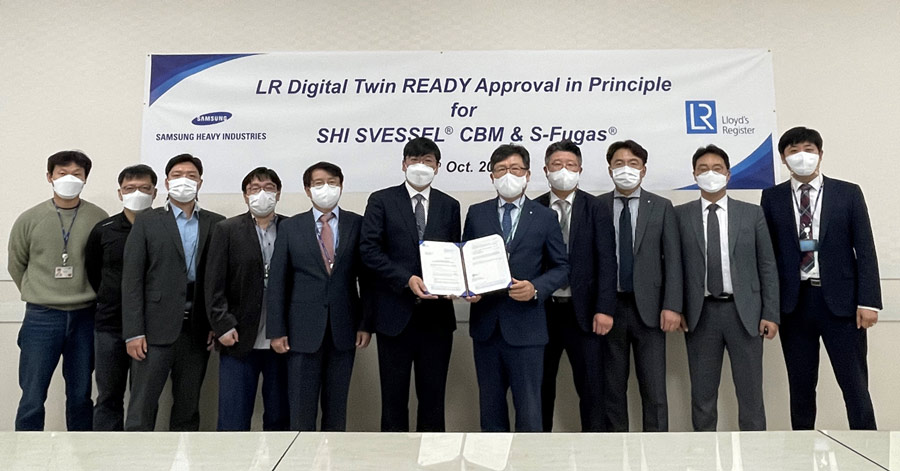Digital twins generated by SHI for its Smart Ship Solution, SVESSEL® CBM and S-Fugas® System receive LR Approval in Principle.
LR has granted Digital Twin Ready Approval in Principle to Samsung Heavy Industries (SHI) for its Smart Ship Solution, SVESSEL® CBM and S-Fugas® (Samsung Fuel Gas) System, a key result of a Joint Development Project (JDP) formed earlier in the year.

This is the first time SHI has been awarded classification society approval for a systems engineering approach for developing artificial intelligence-enabled technology.
As part of the project, SHI generated the digital twin concept and engineering approach for the condition-based maintenance of the rotating machinery in its Smart Ship Solution, SVESSEL® CBM and for the model-based engineering support and system monitoring of its LNG fuel gas supply system, S-Fugas®.
As the only classification society involved in the project, LR’s role was to deliver assurance on the correctness, safety and performance of SHI’s digital twin technology. To do this, LR applied Digital Twin Ready, the first stage of its ShipRight Digital Compliance framework, to qualify SHI’s engineering, software engineering processes, development tools and subject matter experts.
LR experts led by Joseph Morelos from LR’s Group Technology and Innovation team performed a developer capability assessment and evaluated SHI’s systems engineering approach, including its software engineering practices relevant to the development and sustainment of digital twins through-out their life cycle. This led to LR Approval in Principle being awarded.
Young-Doo Kim, LR's North East Asia TSO Manager, said: “This is a significant step in the maritime industry’s journey towards digitalisation and for Samsung Heavy Industries as digital twin technology can help shipowners and operators optimise operation costs and more importantly, improve safety. We’re very proud to have worked with SHI and award this Approval in Principle and look forward to working with them going forward as shipping looks to meet IMO 2050 targets and other challenges.”
Hyun-Jo Kim, Managing Director, SHI, said: "SHI believes digital twin technology shall be a key to open the gateway forward to the next level of unmanned automatically operated ships. Therefore, we'll keep developing the technologies that has granted AiP of Digital Twin Ready for the service enabling real-time health monitoring, diagnosis and remained life-time evaluation of the main equipment of ships."
The AiP was awarded on 20 October 2021 at Samsung Ship Model Basin in Korea, in the presence of Hyun-Jo Kim, Managing Director, SHI and Young-Doo Kim, North East Asia TSO Manager, LR.
This announcement is underpinned by LR’s digital strategy that is focused on delivering tangible benefits to our customers and partners, helping them to drive business outcomes through the safe and appropriate adoption of new technologies. Our digital solutions enable clients to optimise the performance of their assets, their people, and their business, whilst opening new opportunities for growth. Our pathway aligns with what matters most to customers, in line with what technical solutions are right, with a customer led approach.
Notes to Editors
LR’s ShipRight Digital Compliance framework
LR delivers assurance of the safety and performance for the deployed digital and artificial intelligence-enabled technologies for maritime, such as digital twin technology, and applies its LR ShipRight Digital Compliance framework to qualify the technology and its outcomes.
LR’s Digital Compliance framework has four distinct stages, with each stage delivering a unique benefit to both digital twin developer and end user of a digital twin.
- “Digital Twin Ready” Developer capability assessment. Evaluates a developer’s systems engineering approach, including their software engineering practices relevant to the development and sustainment of digital twins through-out their life cycle.
- “Digital Twin Approved” Independent verification of specific digital twin(s). Defines and bounds the capability and limitations of each digital twin under review. Sequentially applies a requirements-based verification of the digital twin, initially via independent analysis then moving to different forms of verification testing.
- “Digital Twin Commissioned” Risk-based resiliency analysis of specific digital twins and their supporting system. Selection and analysis of specific high-consequence false negative events i.e. a digital twin fails to detect a high-consequence failure under coverage. The false negative event is reversed engineered to identify issues such as cyber security vulnerabilities, human factors, etc. and how these can contribute, propagate the false negative event(s) allowing design changes and/or operational mitigations.
- “Digital Twin Live” Validation of specific digital twin(s). Monitors the real-world performance of digital twins initially via controlled introduction into service then continuously via event-based validation of fault detection and diagnostics insights. Validation confirms the reproducibility of correct, accurate digital twin insights including their statistical relevance as the digital twin is scaled via installation across hundreds/thousands of physical assets.





